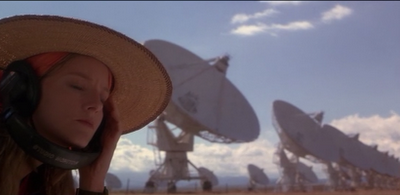 |
| The Green Bank radio telescope in wild, wonderful West Virginia. Source: National Radio Astronomy Observatory. |
Even knowing that we have dozens of large dish antennae able to work together to receive and transmit data, it is still amazing to me that we can communicate with, for example, Voyager 1. That little spacecraft is 17 LIGHT HOURS away from Earth! How do you receive a signal sent by a small transmitter hundreds of millions of miles away?
At this point, there are only two ways to communicate with the Voyagers. Our largest antennae, the 230 foot diameter dishes, are powerful enough to talk to the craft. Or, multiple dishes arrayed together can communicate with the Voyagers. Arraying dishes means aligning individual dishes so that they work together, functioning as an even more powerful device, able to separate the weakest signals from background interference. You can array two dishes at the same Deep Space Network location. You can also array dishes at different locations. For example, dishes at the Very Large Array facility in New Mexico can work together with the dishes at Goldstone, receiving signals that would be too weak for one dish or one facility alone to discern.
 |
| Jodie Foster, putting the Very Large Array to good use. Source: on-walkabout.com. |
According to the Deep Space Network's operations manager, Jim Hodder, recent innovations made to the Network have further improved our ability to talk to the Voyagers. For example, we can now cool a dish antenna's receivers down to near absolute zero (-460 degrees Fahrenheit). This reduces interference with Voyager's radio signal, because any heat above absolute zero knocks electrons out of their lowest energy state orbits, just like radio waves from a spacecraft knock electrons out of their lowest energy state orbits. Less heat means less extraneous movement by electrons. Therefore, it's easier to pick out the one distant radio signal you're looking for.
 |
| Voyager 1, back when it was 17 light hours closer to Earth. Source: Wikipedia. |
When the Voyagers were launched in the late 1970s, we would likely not have been able to communicate with a spacecraft 17 light hours away. But now, it appears that the Voyagers will run out of the power needed to transmit messages before they leave the range of our radio telescopes!
 |
| A Voyager at the edge of the solar system. Source: Space.com. |
There's one other neat fact I've learned about communicating with spacecraft around the solar system. As I mentioned back in my first Deep Space Network post, there are three human-made satellites (Mars Odyssey, Mars Reconnaissance Orbiter, and Mars Express) orbiting Mars right now. As a result of this infrastructure in Mars orbit, our communications with the Curiosity rover are a bit more advanced than for the average interplanetary mission.
 |
| The base of Mount Sharp, as viewed by Curiosity. Source: NASA. |
One, Curiosity can transmit signals directly to the Deep Space Network through a low-gain antenna. This antenna sends and receives data a slower rate in every direction, so that Curiosity doesn't have to point its antenna directly at Earth. Curiosity uses this antenna to transmit information, and, more often, to receive information.
Two, Curiosity also has a high-gain antenna that it can point at Earth to broadcast information directly there. This can send data at a faster rate than the low-gain antenna. Curiosity uses this antenna most often when it is receiving instructions from scientists on Earth.
Three, Curiosity usually communicates with Earth indirectly, via our Martian satellites! It can send and receive information to and from the Mars Reconnaissance Orbiter, Mars Global Surveyor, or Mars Odyssey via a UHF (short-range) antenna.
 |
| The deck of Curiosity, with the low-gain and high-gain antennae visable. Source: JPL. |
As a result of these three methods for accessing the Deep Space Network, we can communicate with Curiosity across tens of millions of miles of outer space at up to half the speed of a typical modem in someone's house!
Sources: io9, JPL, Wikipedia; Space Today; NASA; Popular Mechanics.


Wonderful series about the DSN!
ReplyDeleteBut one thing: Voyager 1 is 34 light hours away? Wikipedia claims it was 16 hours in February.
Thanks for reading the blog, Tony! Whoops, you are right... I mistakenly used the round-trip distance. So, it's half of what I said, about 17 hours as of today. Thanks for correction!
Delete